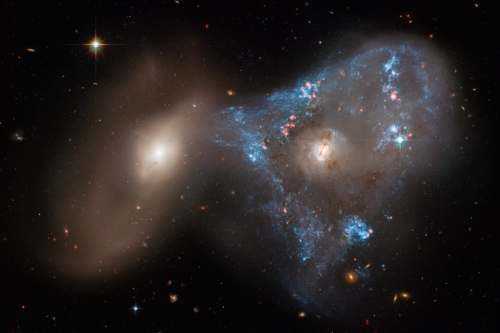Image courtesy of Flickr.
Galactic collisions usually resemble a carefully choreographed ballroom dance: picture a pair of galaxies pinwheeling into each other’s arms, their gravitational centers merging together. But in the case of the two dwarf galaxies DF2 and DF4—initialed in honor of the Dragonfly telescope that captured them—researchers suspect the cause of their formation might have been closer to a collision between two bullets.
The van Dokkum Lab, a Yale astrophysics research group, proposed a bullet-dwarf collision model which describes an event where a pair of galaxies run into each other with enough speed to form two entirely new ones in their wake. The model is a culmination of years of observation and careful telescopic tracking. Van Dokkum’s research team first discovered DF2 and DF4 sometime around 2018. Both galaxies are members of a space neighborhood roughly sixty-seven million light years away from Earth.
What surprised the group was the virtual absence of any dark matter in both DF2 and DF4. The researchers were baffled by the speeds of the galaxies’ stars. “They [had] very low velocity dispersion, which means that […] these galaxies don’t contain a lot of dark matter,” said Zili Shen, a graduate researcher in the lab. The intensity of gravity directly dictates the motion of stars, and since most of a galaxy’s gravitational force comes from dark matter, both DF4 and DF2 must be strikingly devoid of it.
Dark-matter deficient galaxies are uncommon—they are so rare, in fact, that DF4 and DF2 remain just a few of the handful scientists currently know. This is because most galaxies depend on dark matter for their creation. Clumps of dark matter—a substance virtually undetectable except by its gravitational presence—often serve as whirlpool-like centers that collapse clouds of gas. There, temperatures can rise to levels nearly double the sun’s surface temperature, giving birth to a sizzling new galaxy.
Without dark matter to create its stars, DF4 and DF2 must have come into existence following a script of their own. Analyzing the data, the team reasoned that two-parent dwarf galaxies met side-on in a high-speed collision, generating an extraordinary amount of force that compressed their clouds of gas. This might have been enough to form DF2 and DF4. “High-speed collision of dwarf galaxies is a viable explanation for galaxies without dark matter,” Shen said.
Under normal conditions, the comparatively lower speeds would have trapped the dark matter of both parent galaxies and caused them to merge. But for DF4 and DF2, the collision likely occurred with so much velocity that the two haloes of dark matter simply bypassed each other. With nothing left to bind their constituent star clusters together, the once-organized parent galaxies scattered apart. The result: diffuse clouds of gas and stars strewn across space, the DF2/DF4 duo among them.
Their data seems to confirm this. The group’s most recent paper identified a linear arrangement of seven to eleven dimly-lit objects, exactly the kind of structure they would expect to find from a cosmic collision like this. Most structures were also abnormally large for their relative brightness, offering further evidence that they might be the galactic shrapnel of interest.
But like the star clusters of newly formed galaxies, the model remains hazy. At least two other competing theories have attempted to explain this phenomenon. One suggests that DF4 and DF2 simply arose after a normal dwarf galaxy drifted too close to a larger galaxy and lost its dark matter. It fails, though, to explain the presence of two dark-matter deficient galaxies. The second—the tidal dwarf theory—proposes that they arose from gas that was stripped off from larger galaxies, but the lab has since disproven this through the age and metallicity of both galaxies’ constituent stars.
For now, the bullet-dwarf collision remains a tentative—if attractively convincing—hypothetical scenario. “This is mostly a theory that explains the data we already have,” Shen said. Confirming the bullet-dwarf collision will require more empirical evidence, which includes calculations of the individual clusters’ velocities and positions. The group has already started processing data from the Hubble Telescope to further validate their theory.
Studying dwarf galaxies like DF2 and DF4 has its benefits. Shen explained that dwarf galaxies, being almost one thousand times smaller than our Milky Way, are relatively easier to model. That doesn’t make piecing together our strange cosmic past any simpler, but it might just help reveal new ways of being and of becoming that we had previously not known.

